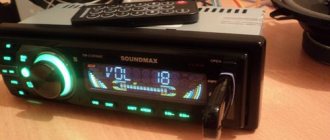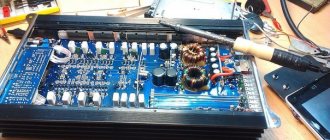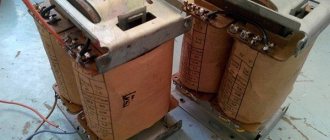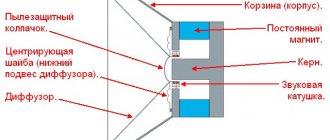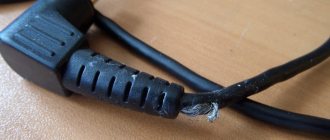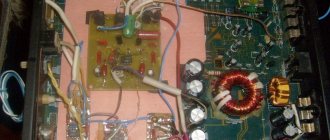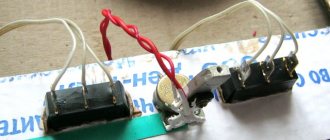In the previous article I talked about making a simple winding machine. It's time to show manufactured transformers for lamp technology. The first was an output transformer for the JCM800 guitar combo amp. I came across good iron 0.35 mm on camber. Good section 12.5 cm2. He began to wind on his machine. I wasn’t in a particular hurry, in 2-3 hours one winding a day. Each layer was impregnated with wax using a hair dryer and a candle, so as not to cook the entire transformer in paraffin later.
Requirements for a transformer product
In order to assemble an output transformer with your own hands, you will first need to understand the following technical issues:
- What circuit will this transformer be connected to?
- What sound power is planned to be obtained at the output of the amplifier with its help.
- What should be the winding characteristics of this device?
Important! Only if all the parameters listed above are chosen correctly will it be possible to construct a high-quality amplifier with excellent sound characteristics over the entire frequency range.
Let us consider each of the conditions for obtaining high-quality amplification in more detail.
Speaker production
The body is made of chipboard and MDF panels 18 mm, respectively, screwed together, additionally glued using Wikol to strengthen the structure and seal. The interior walls are filled with polyester-type damping material, and the rear wall is filled with bitumen coating.
The front of the cabinet is custom-made and is the most expensive part of the design, not counting the speakers (although these are most often obtained for free). There was no milling equipment, so I had to order it, but there is no point in complicating the work when you repeat the AS.
Connection diagram
To make your own amplifier using 6P14P pentodes, you must first select a suitable circuit, which is very easy to do if you have the Internet. To do this, just type the appropriate query in the search bar and select the circuit solution you like best. In this case, it is important to decide on which option the amplifier output unit is supposed to be made of: one or two lamps (one- or two-cycle mode).
Additional information: To obtain high-quality and undistorted sound, preference should be given to the second option (the so-called “two-stroke”).
With this design, the circuit on the left is suitable (for convenience, it includes a preliminary stage on a 6N2P double triode and a power supply with a T2 power transformer).
50 W devices
Speakers (homemade) rated at 50 W are suitable for ordinary acoustic players. In this case, the body can be made from ordinary plywood. Many experts also recommend using natural wood veneer
However, it is important to note that he is afraid of high humidity
After choosing the material, you should work on the speakers. They must be installed next to the bass reflex. In this case, you cannot do without an amplifier. Many experts recommend selecting only low-frequency crossovers. If we consider modifications with a regulator, then they use a pulse diffuser. The terminal block in this case is installed last. You can always use leatherette to decorate the speakers. A simpler option is to varnish the surface.
output power
The output power for the circuit under consideration can range from 12 to 25 watts (with a load resistance of 4 ohms).
Note! In maximum power mode, the distortion factor in this case will be no more than 5%, and the output voltage on the winding of the sound transducer is about one volt.
To obtain optimal power, it is more convenient to count the secondary winding of a push-pull device on the number of turns that corresponds to the complex resistance of the connected speaker (4 or 8 Ohms).
Listening to music
The treble is good, the quality is average, the bass is surprisingly strong, perhaps this feeling is caused by the room in which they are played, but the desktop speakers did not show such kick. Overall a positive experience. The sound is pretty clear. The speakers work great in blues, techno, rap. Excellent female vocals, you can listen to them for a long time without interruption. The speakers are 87 dB and could probably handle up to 100 watts of sound.
Main characteristics
Before winding the output transformer for 6P14P, you should familiarize yourself in more detail with its design, which has the following characteristics:
- The converter consists of two windings representing its primary and secondary multi-section coils.
- The transformer for the lamp device is wound on an Ш30 core.
- The thickness of the set of its plates is 36 mm.
To accommodate both coils of the output transformer for push-pull on 6P14P, the dimensions of its working window must be selected at least 60 by 30 mm.
With such design data of the converter, its winding parameters take on very specific values, which are discussed in the next section.
Winding characteristics of the output transformer
In order to wind the output transformer for a push-pull amplifier on 6P14P, you will need to make a double frame, artificially separated by a special partition.
The location of the winding sections on the transformer frame for 6P14P lamps, as well as the connection diagram for the primary and secondary windings, are shown in the photo.
The primary winding frame has six equally sized sections, each containing 300 turns. The secondary coil is divided into 4 sections containing 44 turns.
Winding sequence
The sequence of winding them with your own hands looks like this:
- First of all, the turns are wound in the sections of the frame, indicated in the photo by numbers 1,8,2,7,3.
- After this, the partially wound structure is removed from the machine and rotated 180 degrees.
- At the next stage of work, winding of the remaining sections, numbered 4,9,5,10,6, continues.
All sections of the primary winding of the output transformer for a 6P14P tube amplifier are connected to each other in a series circuit. In contrast, the secondary coil consists of two halves connected in series, each of which contains two sections connected in parallel.
Additional information: Thanks to this method of forming the coils, the transformer device provides optimal transfer characteristics of the cascade.
The latter means that when the secondary winding is constructed in sections, its coordination with loads of various sizes is simplified.
In addition, this approach to winding coils with your own hands allows you to obtain a symmetrical circuit with a low inductive leakage coefficient. Thanks to this, the assembled cascade has excellent frequency response and phase response characteristics.
Crossover filter
Frameless reels:
- 0.33 MH, 0.480 Ohm, Dr 0.70
- 0.050 MH, 0.090 Ohm, Dr 1.00
Chokes with cores:
- 0.47 MH, 0.160 Ohm, Dr 1.00
- 2.0 MH, 0.400 Ohm, Dr 1.00
Useful: Active car subwoofer that can work autonomously
Resistors:
- 3.6 Ohm, 5 W, metallized,
- 10 Ohm, 5 W, ceramic
- 4.7 Ohm, 5 W, ceramic,
- 10 Ohm, 5 W, metallized.
Capacitors:
- 5.6uf IPC/400V
- 15uf IPC / 400V
- 2.7uf IPC/400V
- 10uF IPC / 400 V
- 0.68uf IPC/400V
- 2.7uf IPC/400V
Power transformer parameters
In order to make a power transformer for a 6P14P tube amplifier, you will need to use a magnetic core based on Sh-40 electrical steel, which has a set thickness of 50 mm. The winding parameters of the converter device are as follows:
- The primary (network) winding should have 430 turns of copper wire in PEL 0.8 insulation.
- Its secondary coil should be wound with PEL-0.31 wire, the number of turns of which should be at least 400 (it powers the rectifier, which provides anode voltages for the lamps).
- In the winding of the filament circuit of the double triode 6N2P (b-b), it is necessary to wind 11 turns of PEL-1.0 wire.
The supply windings operating on the incandescent circuit of lamps L4 and L5 (v-v) each have 13.5 turns of PEL 1.0 wire. Upon completion of the assembly of the power unit, a complete set of electrical devices will be ready for installation in the working circuit.
If all the requirements outlined in the article are met, it is possible to obtain a high-quality output transformer for 6P14P lamps, which guarantees reliable operation of the push-pull amplifier stage.
Recommendations
Place your speakers where they sound best.
Do not use speakers and PCs in damp, dirty areas, or near a source of acidic fumes. This will cause them to deteriorate prematurely.
Do not turn the sound volume higher than recommended. To avoid overloading the amplifier (and its frequent shutdowns due to overheating), use matching elements in the circuit. The speaker should not “wheeze” or produce distortion (“emphasize” high frequencies and reduce the level of low frequencies).
If the speaker is powered from a USB port, overloading the module that produces 5 V due to a voltage drop can lead to its failure. Don't overload your laptop. The same applies to smartphone and tablet chargers.
See below for a master class on making speakers.
Automotive modifications
Car speakers are available with two or three speakers. To assemble the model yourself, you will need sheets of plywood. In some cases, varnished veneer is used. To fix the speaker, you need to make a hole in the panel. The next step is to install the bass reflex. Some modifications are made with low-frequency cores. If we consider speakers (homemade) of low power, then the bass reflex can be installed without an amplifier.
In this case, a multi-channel crossover is used to control sound. Some specialists install terminal blocks behind the bass reflex. If we consider speakers with a power of more than 50 W, then the microcircuits are used for two amplifiers. The diffuser is installed as a standard pulse type
Before fastening the case together, it is important to take care of the vibration-proofing layer. For the terminal block you need to make a separate hole on the plate
Some people believe that the body must be cleaned. The wires for the speakers are of the two-wire type.
Studio devices
Speaker drawings for studios assume the use of powerful speakers. The diffuser is most often used of the pulse type. Many experts recommend installing two amplifiers. For normal operation of the speaker system, a zener diode is required.
In order to assemble the speakers yourself, the housing is first made. Round holes are made on the front panel for the speakers. You will also need a separate output for the bass reflex. The design of the columns is quite different. Some people prefer to varnish the surface of the case. However, there are models covered in leather.



